

2018 APR 7
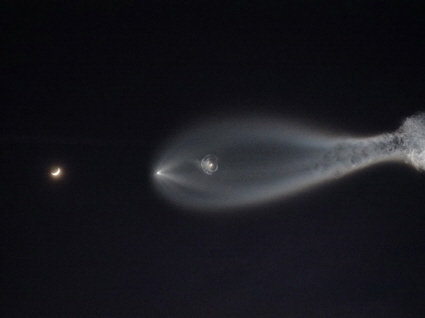
Friday's launch of a Falcon 9 rocket from Vandenberg Air Force Base created a spectacular dusk light show for southern California and beyond. Space Archive contributor TR recorded the rocket's second stage burn in this image. Visible here are the sunlit second stage exhaust plume, half moon, and venting from the spent first stage (the circular feature within the exhaust plume). Image copyright 2017, TR. Used with permission
(DEC 22) VANDENBERG AIR FORCE BASE, Calif. - Team Vandenberg supported the successful launch of the fourth Iridium mission on a SpaceX Falcon 9 rocket from Space Launch Complex-4 here Friday, Dec. 22, at 5:27 p.m. PST.
Col. Michael S. Hough, 30th Space Wing commander, was the space launch commander.
"What a way to end the year with the fifth Falcon 9 launch carrying the fourth set of Iridium satellites. This mission proves that Team V provides assured access to space and we do it safely and securely," said Hough. "It goes without saying that we can't accomplish this without great mission partners like SpaceX."
Vandenberg AFB
(DEC 13) A pair of advanced U.S./German Earth research satellites with some very big shoes to fill is now at California's Vandenberg Air Force Base to begin final preparations for launch next spring. More
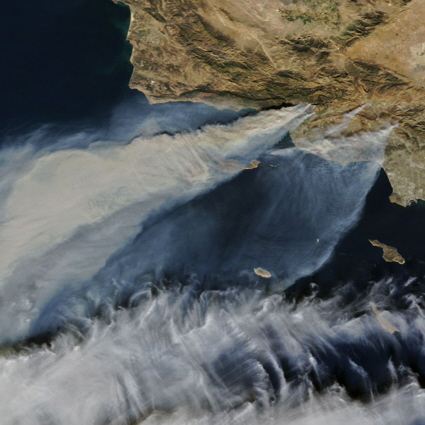
Thick smoke streams from several fires in southern California in this cropped version of a natural-color image recorded by NASA’s Terra satellite on December 5. The largest of the blazes—the fast-moving Thomas fire in Ventura County—had charred more than 65,000 acres (24,000 hectares or 94 square miles), according to Cal Fire. Smaller smoke plumes from the Creek and Rye fires are also visible. Terra was launched from Vandenberg AFB, Calif. in 1999. Image courtesy of NASA
(DEC 6) Vandenberg Air Force Base, Calif. - The ULA Delta IV rocket carrying the NROL-47 payload for the National Reconnaissance Office is delayed in order to perform additional validation of the software and systems associated with Common Avionics. Common Avionics is a newly designed suite of avionics, flight software and ground systems that will fly on both Atlas V and Delta IV. This upgraded command and control system was designed to reduce cost and improve reliability. NROL-47 will be the first flight of the Common Avionics system on Delta IV. The vehicle and spacecraft remain stable. Launch of the NROL-47 mission is scheduled for no earlier than Wednesday, Jan. 10, 2018.
United Launch Alliance
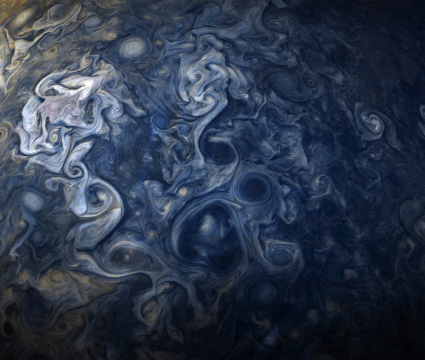
Swirling blue clouds in Jupiter's atmosphere mimic an abstract painting in this recently released Juno spacecraft image. Juno recorded it when the probe was only 11,747 miles (18,906 kilometers) from the cloud tops. Citizen scientists Gerald Eichstädt and Seán Doran later processed the image to create this view. NASA's Jet Propulsion Laboratory in Pasadena, Calif. manages the Juno mission for the principal investigator, Scott Bolton, of Southwest Research Institute. Image credits: NASA/JPL-Caltech/SwRI/MSSS/Gerald Eichstädt/ Seán Doran
(NOV 20) Astronomers recently scrambled to observe an intriguing asteroid that zipped through the solar system on a steep trajectory from interstellar space-the first confirmed object from another star. More
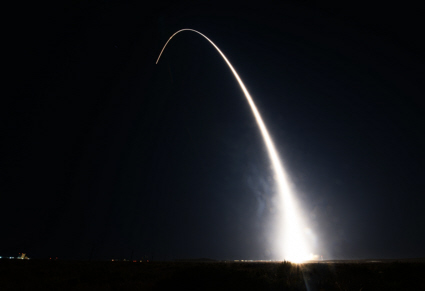
A United Launch Alliance Delta II rocket carrying a NASA/National Oceanic and Atmospheric Administration satellite successfully launches from Space Launch Complex-2, Vandenberg Air Force Base, Calif. on November 18. U.S. Air Force photo by Senior Airman Ian Dudley
(NOV 18) VANDENBERG AIR FORCE BASE, Calif. - A United Launch Alliance Delta II rocket carrying a NASA/National Oceanic and Atmospheric Administration satellite was successfully launched from Space Launch Complex-2 here Saturday, Nov. 18, at 1:47 a.m. PST.
To view the 30th Space Wing Public Affairs media video launch highlights visit: https://www.dvidshub.net/video/566483/delta-ii-launch-successful
To view the 30th Space Wing Public Affairs launch photos visit: http://www.vandenberg.af.mil/News/ or www.facebook.com/30thSpaceWing
Vandenberg AFB
(NOV 16) Vandenberg Air Force Base, Calif. - The launch of a United Launch Alliance Delta II rocket carrying the JPSS-1 mission for NASA and NOAA is confirmed on the Western Range for Saturday, Nov. 18. The launch time is 1:47 a.m. PT.
United Launch Alliance
(NOV 15) Vandenberg Air Force Base, Calif. - The launch of a United Launch Alliance Delta II rocket carrying the JPSS-1 mission for NASA and NOAA was scrubbed today due to a range safety hold and high upper level winds. The team is working to establish a new launch opportunity.
United Launch Alliance
(NOV 14) Vandenberg Air Force Base, Calif. – The launch of a United Launch Alliance Delta II carrying the JPSS-1 mission for NASA and NOAA was scrubbed today due to a red range and a late launch vehicle alarm. Due to the short window there was insufficient time to fully coordinate a resolution.
The launch is planned for Wednesday, Nov. 15, from Space Launch Complex-2 at Vandenberg Air Force Base, California. The launch time is 1:47 a.m. PT.
United Launch Alliance
(NOV 8) VANDENBERG AIR FORCE BASE, Calif. - The launch of a United Launch Alliance Delta II, carrying the NASA/National Oceanic and Atmospheric Administration's Joint Polar Satellite System-1 (JPSS-1) satellite from Space Launch Complex-2 here, is rescheduled for Tuesday, Nov. 14, at 1:47 a.m. PST.
Vandenberg AFB
(NOV 6) Vandenberg Air Force Base, Calif. - The ULA Delta II rocket carrying the JPSS-1 mission for NASA and NOAA is delayed, due to a faulty battery. The delay allows the team time to replace the battery on the Delta II booster. The vehicle and spacecraft remain stable. Launch of the JPSS-1 mission is scheduled for no earlier than Tuesday, Nov. 14, 2017.
United Launch Alliance
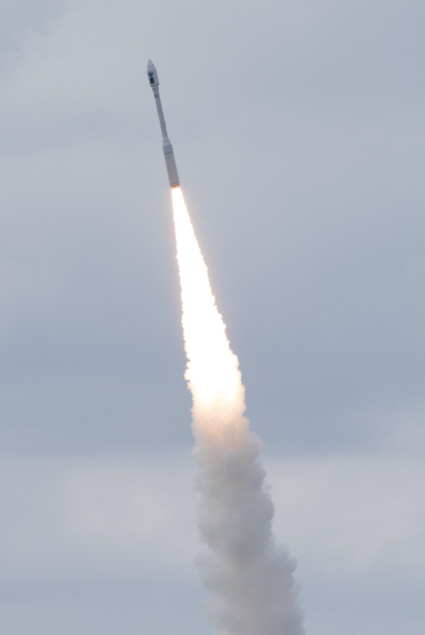
A Minotaur-C rocket carrying 10 small satellites for Planet, climbs following liftoff from Space Launch Complex 576-E at Vandenberg AFB on October 31. U.S. Air Force photo by Michael Peterson
(OCT 31) VANDENBERG AIR FORCE BASE, Calif. - The Orbital ATK Minotaur-C rocket, carrying 10 small satellites owned by Planet, launched from Space Launch Complex 576-E here Tuesday, Oct. 31, at 2:37 p.m. PDT.
Col. Greg Wood, 30th Space Wing vice commander, was the space launch commander.
"This launch was an incredible achievement for Team Vandenberg, Orbital ATK, and our other launch partners," said Wood. "This Minotaur-C launch marked the first at Vandenberg in six years and I am very proud of the teamwork that led to this successful launch. The hard work and dedication of everyone involved continues to ensure our nation's access to space."
Vandenberg AFB
(OCT 27) VANDENBERG AIR FORCE BASE, Calif. -- Team Vandenberg is scheduled to launch the Skybox imaging satellite aboard the Orbital ATK Minotaur-C rocket from Space Launch Complex 576-E here, Tuesday, Oct. 31, at 2:37 p.m. PDT.
Col. Greg Wood, 30th Space Wing vice commander, is the space launch commander.
"Our unique geographic location makes Vandenberg an ideal place to launch commercial imaging satellites," said Wood. "We are excited to partner with Orbital ATK to make this mission a reality."
Due to the remoteness of the launch site, the Hawk's Nest on Hwy 1 south of Vandenberg Air Force Base's main gate will not be open.
Vandenberg AFB

Typhoon Lan swirls in the western Pacific in this October 20 natural-color image from the Suomi NPP spacecraft. The storm had maximum sustained winds of 90 knots (105 miles or 165 kilometers per hour) and had an eye estimated to be 50 miles (80 kilometers) wide. Suomi NPP was launched from Vandenberg AFB, Calif. aboard a Delta II rocket in 2011. NASA image by Jeff Schmaltz, LANCE/EOSDIS Rapid Response.
(OCT 19) Centennial, Colo. – NASA’s Launch Services Program announced today that it selected United Launch Alliance’s (ULA’s) proven Atlas V vehicle to launch the Landsat 9 mission, the ninth in the satellite program providing the longest continuous global record of Earth’s surface. This award resulted from a competitive Launch Service Task Order evaluation under the NASA Launch Services II contract.
The Landsat 9 mission is scheduled with a contract launch date of June 2021 while protecting for the ability to launch as early as December 2020 from Space Launch Complex-3 at Vandenberg Air Force Base in California. This mission will launch aboard an Atlas V 401 rocket.
The Landsat program is a multi-satellite partnership between NASA and the U.S. Geological Survey to monitor, understand, and manage the land resources needed to sustain human life. Landsat is the only U.S. satellite system designed and operated to repeatedly observe the global land surface at a moderate scale that shows both natural and human-induced change. Every day, Landsat satellites provide essential information to help land managers and policy makers make wise decisions about our resources and our environment.
United Launch Alliance
(OCT 9) VANDENBERG AIR FORCE BASE, Calif. -- Team Vandenberg supported the successful launch of 10 Iridium satellites on a SpaceX Falcon 9 rocket from Space Launch Complex-4 here Monday, Oct. 9, at 5:37 a.m. PDT.
Col. Michael S. Hough, 30th Space Wing commander, was the space launch commander for this mission.
"This is the fourth Falcon 9 and the third Iridium NEXT launch in 2017 from Vandenberg," said Hough. "This launch continues to highlight the extraordinary level of teamwork and precision that exists between Team Vandenberg and SpaceX."
This was the third Falcon 9 launch supporting the deployment of Iridium Communication Inc. global satellite constellation, Iridium NEXT. Each launch contributes to replacing the world's largest commercial satellite network and the only network that covers 100 percent of the earth. Iridium NEXT will enable new capabilities like Aireon's real-time, global aircraft surveillance and tracking service, and Iridium Certus, the Company's next-generation communications platform that will bring broadband speeds to even the world's most remote locations.
Vandenberg AFB
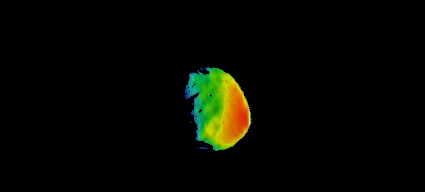
Mars' normally gray moon Phobos displays a range of colors in this composite image from NASA's Mars Odyssey spacecraft. This view combines two products from the first pointing at the Martian moon Phobos by the Thermal Emission Imaging System (THEMIS) camera on the spacecraft, on Sept. 29. Surface-temperature information from observation in thermal-infrared wavelengths is overlaid on a more detailed image from a visible-light observation. THEMIS was developed by and is operated by a team based at Arizona State University, Tempe. Image Credit: NASA/JPL-Caltech/ASU
(OCT 3) VANDENBERG AIR FORCE BASE, Calif. - Team Vandenberg is scheduled to launch the third Iridium mission consisting of 10 satellites on a SpaceX Falcon 9 rocket from Space Launch Complex-4 here Monday, Oct. 9, at 5:37 a.m. PDT.
Col. Michael S. Hough, 30th Space Wing commander, is the space launch commander.
"Our mission is to provide assured access to space and to do it safely and securely. We can't accomplish this without great mission partners like SpaceX," said Hough. "SpaceX's and 30 SW's ever present 'can-do-attitude' and job pride will be on display for the Iridium-3 launch."
Due to the early morning launch time, the Hawk's Nest on Hwy 1 south of Vandenberg Air Force Base's main gate will not be open.
Vandenberg AFB
(SEP 29) EL SEGUNDO, Calif., Sept. 29, 2017 – Boeing [NYSE: BA] has successfully supported seven out of seven satellite launches this year, including today’s launch of a 702 high-throughput digital payload satellite, built for Intelsat.
Intelsat 37e sent and received its first signals from space shortly after it launched today on board an Arianespace Ariane 5 rocket. Once in service, the satellite will deliver high-throughput services to support enterprise, broadband, government and mobility applications in the Americas, Africa and Europe.
“This latest launch is an example of our emphasis on quality and reliability to deliver the right products and capabilities to our customers,” said Paul Rusnock, chairman and CEO, Boeing Satellite Systems International, Inc. “Boeing’s market-leading digital payload technology gives our customers the flexibility to adapt to surges in demand for connectivity when and where it is needed, as well as adapt to any changes in their business needs or missions.”
Intelsat 37e is the second Intelsat EpicNG satellite built by Boeing to launch this year and the fourth Intelsat EpicNG satellite built by Boeing. Intelsat 35e, which launched in July 2017 from Cape Canaveral Air Force Base, Fla., was handed over to the customer last month.
For more information on Defense, Space & Security, visit www.boeing.com. Follow us on Twitter: @BoeingDefense
Boeing
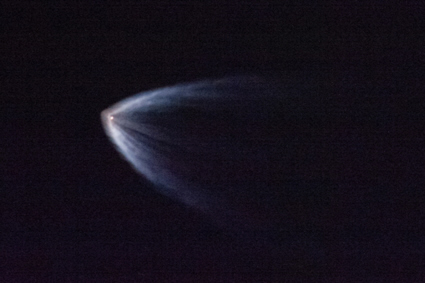
An Atlas V rocket carrying a classified payload races into orbit following liftoff from Vandenberg AFB, Calif. late on the evening of September 23. Jerry Jacob took this photo of the launch late in the first stage burn from a vantage point near Los Angeles International Airport (LAX). Visible here are the light from the first stage engines (star-like dot) trailed by the large v-shaped exhaust plume. Copyright 2017, Jerry Jacob. Used with permission.
(SEP 24) VANDENBERG AIR FORCE BASE, Calif. -- Team Vandenberg successfully launched a National Reconnaissance Office payload on a United Launch Alliance Atlas V from Space Launch Complex-3 here Saturday, Sep. 23, at 10:49 p.m. PDT.
Col. Greg Wood, 30th Space Wing vice commander, was the Space Launch Commander.
"Team members of the 30th Space Wing, our partners at the National Reconnaissance Office, and United Launch Alliance worked together to ensure the success of this critical mission," said Wood. "This unified effort is what delivers the essential reconnaissance capability to the nation."
The 30th Space Wing at Vandenberg Air Force Base manages the safety and launch operations from the Western Range.
"We've worked diligently over the course of many months to conduct mission assurance for launch site operations and reduce technical risk," said Lt. Col. Kenneth Decker, 4th Space Launch Squadron commander. "We are very proud to be part of the team that contributed to the success of this mission."
Vandenberg AFB
(SEP 22) (Vandenberg Air Force Base, Calif.) - The ULA Atlas V rocket carrying the NROL-42 mission for the National Reconnaissance Office is confirmed on the Western Range for Saturday, Sept. 23. The launch time is 10:30 p.m. Pacific. The battery replacement is on schedule and the ULA and customer teams are ready to support this new launch date.
United Launch Alliance
(SEP 21) Vandenberg Air Force Base, Calif. - The ULA Atlas V rocket carrying the NROL-42 mission for the National Reconnaissance Office has been delayed. The delay allows the team time to replace a faulty battery on the Atlas V booster. The vehicle and spacecraft remain stable. Launch of the NROL-42 mission is scheduled for no earlier than Saturday, Sept. 23, 2017.
United Launch Alliance

Saturn's active, ocean-bearing moon Enceladus sinks behind the giant planet in a farewell portrait from NASA's Cassini spacecraft. The spacecraft recorded this view before its mission-ending plunge into Saturn's atmosphere on September 15. The Jet Propulsion Laboratory in Pasadena, Calif. JPL, managed the mission for NASA's Science Mission Directorate in Washington, D.C. Credits: NASA/JPL-Caltech/Space Science Institute
(SEP 15) Vandenberg Air Force Base, Calif. - The ULA Atlas V carrying the NROL-42 mission in support of national security is scheduled for Sept. 21 from Space Launch Complex-3 at Vandenberg Air Force Base in California. The ULA team is on track with launch processing to support this date.
United Launch Alliance
(SEP 8) Vandenberg Air Force Base, Calif. - The ULA Atlas V carrying the NROL-42 mission scheduled for Sept. 14 from Vandenberg Air Force Base has been postponed. The launch vehicle and spacecraft are healthy and secure at Space Launch Complex-3.
The decision to delay launch is based on the current forecasting for Hurricane Irma. Some critical members of the ULA launch team that support launch on both coasts are returning to Florida due to the threat from Hurricane Irma which is currently forecast to impact the Cape Canaveral area early Monday morning. The safety of our employees and their families are at the forefront of this decision. Hurricane preparations and hardware securing are underway at Cape Canaveral Air Force Station in Florida. A new launch date for the NROL-42 mission will be determined once the impacts of the storm are understood.
United Launch Alliance
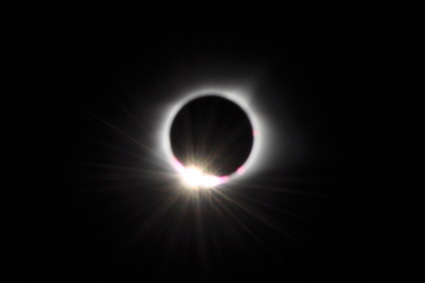
The last bit of sunlight shines along the Moon's edge before day turns to night during August's total solar eclipse. Ventura County resident Rick Slater recorded this view of the spectacle on August 21 from Nashville, Tennessee using a Nikon D5000 camera and 200mm lens. Image copyright 2017, Rick Slater. Used with permission.
(SEP 1) FLAGSTAFF, Ariz. - What happens when a meteoroid the size of a house comes too close for comfort? When a 17-meter rock hurled through Earth’s atmosphere in 2013 and exploded mid-air above the Russian city of Chelyabinsk, it unleashed a shock wave equivalent to 10 times the energy of the Hiroshima atomic bomb, shattering windows and blowing people off their feet.
Until recently, astronomers believed there were nearly 35 million small Near Earth Objects (NEOs) between 10 and 20 meters in diameter, whose orbits bring them close enough to Earth to pose potential impact hazards capable of causing widespread destruction. But a new study published in the Astronomical Journal by Northern Arizona University associate professor David Trilling found there are approximately 3.5 million NEOs larger than 10 meters, about 90 percent of which are in the range of 10-20 meters.
Based on observations made using the Dark Energy Camera on the 4-meter Blanco telescope at the Cerro Tololo Inter-American Observatory, which sits high in the Chilean Andes, the study lends new insights into the nature and origin of small meteoroids and helps us better understand the impact risk of these objects.
Although the study estimates the number of NEOS to be 10 times smaller than previously thought, the perceived impact threat from these house-sized objects is not necessarily lower, Trilling warned.
“If house-sized NEOs are responsible for Chelyabinsk-like events, our results seem to say that the average impact probability of a house-sized NEO is actually 10 times greater than the average impact probability of a large NEO,” Trilling said. “That sounds strange, but it may be telling us something interesting about the dynamical history of NEOs.”
Trilling speculates the small NEOs are concentrated in orbiting bands of collisional debris that are more likely to impact Earth than larger NEOs, and that bands of debris could be produced when larger NEOs fragment into swarms of smaller boulders. He believes testing this hypothesis is an interesting problem for the future.
At NAU, Trilling studies the evolution of the solar system and planetary systems. Working mostly with telescopes in Arizona, Hawaii and Chile, Trilling’s research focuses on the physical properties of asteroids and other small bodies in the solar system. At any given time, Trilling may be doing research for several projects funded by NASA and the National Science Foundation aimed at adding to our understanding of the asteroids with orbits near Earth.
Kerry Bennett, Northern Arizona University
(AUG 24) VANDENBERG AIR FORCE BASE, Calif. - Team Vandenberg launched the FORMOSAT-5 satellite on a SpaceX Falcon 9 rocket from Space Launch Complex-4 here Thursday, Aug. 24, at 11:51 a.m. PDT.
Col. Gregory E. Wood, 30th Space Wing vice commander, was the launch safety authority.
"The 30th Space Wing takes great pride in supporting another successful SpaceX launch," said Wood. "It is a sterling example of the wing's commitment to public safety and mission success on the Western Range."
SpaceX's Falcon 9 rocket delivers FORMOSAT-5, an Earth observation satellite for Taiwan's National Space Organization, to a low-Earth orbit.
"The Falcon 9 launch of Formosat-5 was an incredible mission to be a part of! This was the first satellite manufactured and integrated entirely by Taiwan and it was also the fastest turn-around time between Falcon launches here at Space Launch Complex-4," said Capt. Kylie Prachar, Air Force Launch Commander for F9-40 Formosat-5 mission, 1st Air and Space Test Squadron. "Our Air Force team put in a lot of work to support the mission and provide Fleet Surveillance on behalf of the Space and Missile Systems Center."
FORMOSAT-5 will operate in a sun synchronous orbit at an altitude of 720-km with a 98.28 degree inclination angle. As with the FORMOSAT-2 satellite, the primary payload on FORMOSAT-5 is an optical Remote Sensing Instrument (RSI), which provides 2-meter resolution panchromatic (black & white) and 4-meter resolution multi-spectral (color) images. FORMOSAT-5 also hosts a secondary scientific payload, an Advanced Ionospheric Probe, developed by Taiwan's National Central University.
Vandenberg AFB
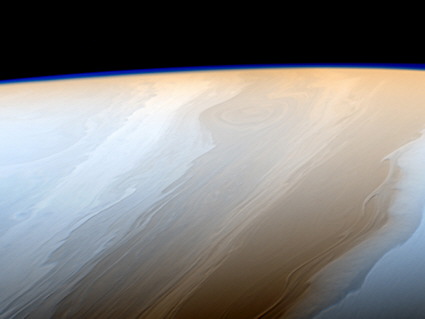
Clouds on Saturn take on the appearance of strokes from a cosmic brush in this recently released false color view created from images taken by NASA's Cassini spacecraft. The Cassini orbiter and its two onboard cameras were designed, developed and assembled at the Jet Propulsion Laboratory in Pasadena, Calif. Image courtesy NASA/JPL-Caltech/Space Science Institute
(AUG 14) VANDENBERG AIR FORCE BASE, Calif. - Team Vandenberg is scheduled to launch the FORMOSAT-5 satellite on a SpaceX Falcon 9 rocket from Space Launch Complex-4 here Thursday, Aug. 24, between 11:50 a.m. and 12:34 p.m. PDT.
Col. Gregory E. Wood, 30th Space Wing vice commander, will be the launch safety authority.
"We are proud to provide a safe and secure launch location for our mission partners," said Wood. "This mission is the practical demonstration of the professional spirit and teamwork found in the everyday operations of Team Vandenberg and SpaceX."
The local community can view this launch from the Hawk's Nest on Hwy 1 south of Vandenberg Air Force Base's main gate. Gate opens at 10:30 a.m. and closes at 11:40 a.m. As a reminder the public is asked not to bring or consume alcohol, smoke, nor have any open fires or barbeques. Weapons are not allowed, additionally, the use of small unmanned aerial systems within five miles of any active runway is prohibited.
Vandenberg AFB
(AUG 8) PALO ALTO, Calif. – Scientists will get a better understanding of our planet’s carbon cycle and vegetation health through a first-of-a-kind NASA instrument built by Lockheed Martin (NYSE: LMT). The Geostationary Carbon Cycle Observatory (GeoCARB) mission will use an advanced infrared spectrograph hosted on a commercial geosynchronous satellite. The project is led by Principal Investigator Dr. Berrien Moore at the University of Oklahoma.
Lockheed Martin’s Advanced Technology Center in Palo Alto, California, will build the instrument, which has its roots in the Near Infrared Camera on the James Webb Space Telescope. Instead of staring into deep space, this mission will examine infrared wavelengths to measure carbon dioxide, carbon monoxide and methane in Earth’s atmosphere along with Solar Induced Fluorescence, a measure of vegetation health. GeoCARB is expected to launch in 2022.
The instrument will be launched as a hosted payload on an upcoming commercial satellite in geostationary orbit over the Americas. This expands the corporation’s experience in hosted payload integration, made possible by innovative instruments that offer compact and affordable capability. This cost-capped mission will demonstrate the ability to perform hosted geosynchronous payload missions at a fraction of the cost of a standalone mission.
The Lockheed Martin team brings together the heritage of more than 100 payloads and instruments launched in the past 30 years. Lockheed Martin’s expertise in Earth remote sensing includes recent successes like the Earth Polychromatic Imaging Camera (EPIC), which streams high-resolution imagery of the planet from its observation station one million miles away; and the Geostationary Lightning Mapper, whose first of four units launched Nov. 19, 2016 aboard the new Geostationary Operational Environmental Satellite R-Series satellite.
Lockheed Martin
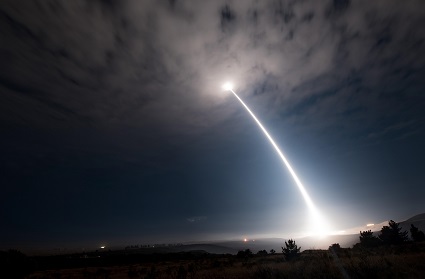
An unarmed Minuteman III intercontinental ballistic missile launches during an operational test at Vandenberg Air Force Base, Calif. (U.S. Air Force photo/Senior Airman Ian Dudley)
(AUG 2) VANDENBERG AIR FORCE BASE, Calif. - An unarmed Minuteman III intercontinental ballistic missile was launched during an operational test at 2:10 a.m., PDT, here Aug. 2.
Col. Michael Hough, 30th Space Wing commander, was the launch decision authority.
"The seamless partnership of Team V and our Air Force Global Strike Command mission partners has resulted in another safe Minuteman III operational test launch," said Hough. "This combined team of the 90th Missile Wing, 576th Flight Test Squadron and 30th Space Wing is simply outstanding. Their efforts over the past few months show why they are among the most skilled operators in the Air Force."
Vandenberg AFB
(JUL 28) WASHINGTON — The Defense Department detected and tracked a single North Korea missile launch today at about 10:41 a.m. EDT, Pentagon spokesman Navy Capt. Jeff Davis said today in a statement.
The department believes the missile was an intercontinental ballistic missile, as had been expected, Davis said.
Davis said the missile was launched from Mupyong-ni, and traveled about 620 miles before splashing down in the Sea of Japan. The Defense Department, he added, is working with its interagency partners on a more detailed assessment.
No Threat to North America
The North American Aerospace Defense Command determined the missile launch from North Korea did not pose a threat to North America, Davis said.
The United States’ commitment to the defense of its allies, including South Korea and Japan, in the face of these threats, remains ironclad, the spokesman said.
The United States also remains prepared to defend itself and its allies from any attack or provocation, he added.
Department of Defense

A C-17 assigned to the 418th Flight Test Squadron airdrops an intermediate range ballistic missile target as part of a Missile Defense Agency test July 11 over the Pacific Ocean. (U.S. Air Force image)
(JUL 19) EDWARDS AIR FORCE BASE, Calif. -- A C-17 Globemaster III assigned to the 418th Flight Test Squadron air-launched a ballistic missile target over the Pacific Ocean north of Hawaii July 11.
The Terminal High Altitude Area Defense weapon system located at Pacific Spaceport Complex Alaska in Kodiak, Alaska, detected, tracked and intercepted the target. Preliminary indications are that planned flight test objectives were achieved and the threat-representative, intermediate-range ballistic missile target was successfully intercepted by the THAAD weapon system, according to the Missile Defense Agency.
An MDA press release said this was the 14th successful intercept in 14 attempts for the THAAD weapon system. The THAAD element provides a globally-transportable, rapidly-deployable capability to intercept ballistic missiles inside or outside the atmosphere during their final, or terminal, phase of flight. The MDA says THAAD is strictly a defense system. The system uses hit-to-kill technology whereby kinetic energy destroys the incoming target. The high-altitude intercept mitigates effects of enemy weapons before they reach the ground.
The 418th FLTS has supported these MDA tests over the years.
The successful demonstration of THAAD against an IRBM-range missile threat bolsters the country’s defensive capability against developing missile threats in North Korea and other countries around the globe and contributes to the broader strategic deterrence architecture, said the MDA release.
Video from the test can be viewed at the Edwards AFB YouTube page here.
412th Test Wing Public Affairs
(JUL 11) PASADENA, Calif. - The car-size NASA rover on a Martian mountain, Curiosity, has begun its long-anticipated study of an iron-bearing ridge forming a distinctive layer on the mountain's slope. More
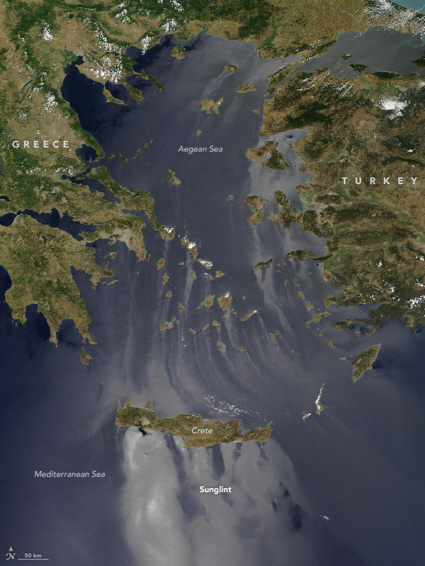
The Aegean Sea and surrounding land areas are visible in this daylight view taken by NASA's Terra spacecraft on July 6. It is one of numerous impressive images returned by Terra since its launch from Vandenberg AFB in 1999. NASA image by Jeff Schmaltz, LANCE/EOSDIS Rapid Response
(JUL 7) A new and large sunspot is rapidly growing on the solar disk, temporarily arresting the sun's plunge into Solar Minimum. Stretching more than 70,000 km from end to end, the active region numbered AR2665 has more than doubled in size in 24 hours. This makes it an easy target for backyard solar telescopes. So far the growing sunspot has not produced any strong flares, but this could change if its rapid growth continues apace and destabilizes the sunspot's magnetic field.
Spaceweather.com
(JUN 30) An ocean-measuring satellite launched from Vandenberg AFB will soon assume an additional role. More
(JUN 25) VANDENBERG AIR FORCE BASE, Calif. -- Team Vandenberg supported the successful launch of ten Iridium NEXT satellites on a SpaceX Falcon 9 rocket from Space Launch Complex 4E here Sunday, Jun. 25, at 1:25 p.m. PDT.
This was the first launch for Col. Michael S. Hough, 30th Space Wing commander, since he took command on June 9th.
"We are once again proud to support another successful launch of Iridium NEXT," said Hough. "This launch is a perfect demonstration of the high level of teamwork and precision that exists between Team Vandenberg and SpaceX."
This was the second of eight planned Falcon 9 launches supporting the deployment of Iridium’s next generation global satellite constellation, Iridium NEXT. Each launch contributes to replacing the world’s largest commercial satellite network and the only network that covers 100 percent of the earth. Iridium NEXT will enable new capabilities like Aireon’s real-time, global aircraft surveillance and tracking service, and Iridium Certus?, the Company’s next-generation communications platform that will bring broadband speeds to even the world’s most remote locations
Vandenberg AFB
(JUN 14) VANDENBERG AIR FORCE BASE, Calif. -- Team Vandenberg is scheduled to launch the Iridium NEXT satellite on a SpaceX Falcon 9 rocket from Space Launch Complex-4 here Sunday, June 25, at 1:25 p.m. PDT.
This will be the first launch for Col. Michael S. Hough, 30th Space Wing commander, who took command on June 9th.
"I'm excited my first launch opportunity is in partnership with SpaceX," said Hough. "And being a part of putting Iridium NEXT in orbit to meet the growing demand for global mobile communication is icing on the cake. As a side, this will also be our first launch with the Autonomous Flight Safety System, which is expected to help decrease launch costs and improve turnaround times between launches."
The Autonomous Flight Safety System debuted on its maiden flight from Kennedy Space Center on a Falcon 9 rocket earlier this year, leveraging software developed at the 30th Space Wing.
This is the second of eight planned Iridium NEXT launches. Each launch will contribute to replacing the world’s largest commercial satellite network and the only network that covers 100 percent of the earth. Iridium NEXT will enable new capabilities like Aireon’s real-time, global aircraft surveillance and tracking service, and Iridium Certus, the Company’s next-generation communications platform that will bring broadband speeds to even the world’s most remote locations.
For more information about the Iridium NEXT satellite, visit: www.iridium.com
Vandenberg AFB
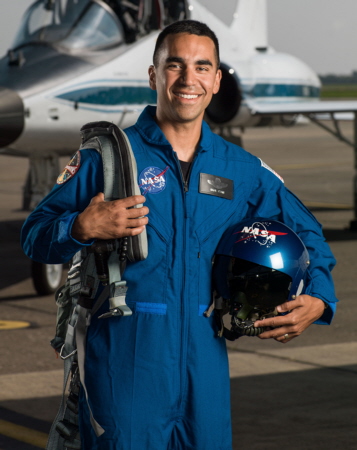
Air Force Lt. Col. Raja Chari stands in front of an NASA T-38 Talon supersonic trainer aircraft at Ellington Field in Houston, Texas, June 6, 2017. Chari has been selected to join the 2017 NASA Astronaut Candidate Class. NASA photo by Robert Markowitz
(JUN 8) EDWARDS AIR FORCE BASE, Calif. — NASA has selected the commander of the 461st Flight Test Squadron here to join the 2017 astronaut candidate class.
Air Force Lt. Col. Raja Chari, who has been selected for promotion to colonel, relinquishes command of the squadron tomorrow. He has overseen developmental testing of the F-35 Lightning II joint strike fighter for the past couple of years while simultaneously serving as director of the F-35 Integrated Test Force.
Chari has flown more than 2,000 flight hours in the F-35 Lightning II, F-15E Strike Eagle, F-16 Fighting Falcon, and F-18 Hornet, including F-15E combat missions in Operation Iraqi Freedom and deployments in support of the Korean Peninsula.
The Iowa native graduated from the U.S. Air Force Academy in 1999 with bachelor’s degrees in astronautical engineering and engineering science. He earned a master’s degree in aeronautics and astronautics from Massachusetts Institute of Technology and graduated from the U.S. Naval Test Pilot School.
412th Test Wing/Department of Defense
(MAY 30) VANDENBERG AIR FORCE BASE, Calif., -- A Raytheon Company (NYSE: RTN) upgraded Exoatmospheric Kill Vehicle, or EKV, a kinetic-force weapon that slams into its targets, destroyed an intercontinental ballistic missile for the first time during a Missile Defense Agency test of the Ground-based Midcourse Defense system.
It was the tenth intercept for the GMD program, which is designed to protect the U.S. against long-range ballistic missile attacks by destroying incoming threats while they are still in space, safely outside the Earth's atmosphere.
The ICBM range target was launched from the Reagan Test site on Kwajalein Atoll, and the interceptor was fired from Vandenberg Air Force Base, California. After receiving tracking and targeting data from sea and space-based sensors, the EKV identified the threat, discriminated between the target and countermeasures, maneuvered into the target's path and destroyed it using "hit-to-kill" technology.
The testing was supported by Raytheon's sea-based X-band radar (SBX) and AN/TPY-2 radar. Both play critical roles in supporting the GMD system.
Raytheon
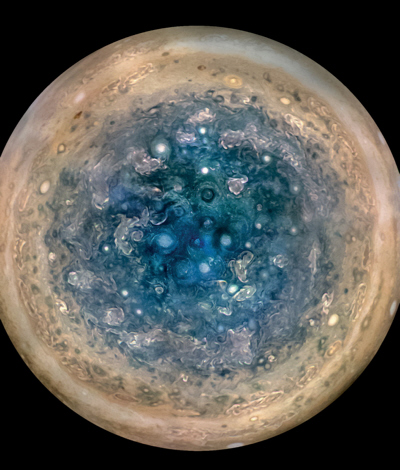
Cyclones up to 600 miles (1,000 kilometers) in diameter and a wealth of detail are visible in this view of Jupiter’s south pole from NASA’s Juno spacecraft released by the Jet Propulsion Laboratory (JPL) on May 25. Multiple images taken on three separate orbits were combined to show all areas in daylight, enhanced color, and stereographic projection. JPL manages the Juno mission for the principal investigator, Scott Bolton, of the Southwest Research Institute. Image credit: NASA/JPL-Caltech/SwRI/MSSS/Betsy Asher Hall/Gervasio Robles
(MAY 27) A Ground-based Interceptor (GBI) missile is scheduled for launch from Vandenberg AFB on May 30 during a 12:00-16:14 PDT launch window. The event is part of a missile defense test that calls for the GBI to intercept a target launched from the central Pacific.
If the sky is clear, the midday-afternoon GBI launch could be visible to the unaided eye for more than 50 miles. However, the intercept will probably not be visible.
According to the Vandenberg AFB web site, off-base public viewing will be available on Corral Road.
Since this is a test of a critical weapon system, launch status and countdown information will probably only be available on-base and at the public viewing area on Corral Road.
Brian Webb
(MAY 16) WHITE SANDS MISSILE RANGE, N.M. - The emergence of the night sky signals the beginning of a mission for a select group of airmen here. More
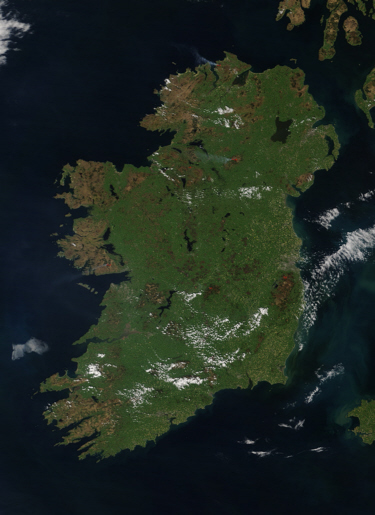
Since its launch from Vandenberg AFB, Calif. in 1999, NASA's Terra spacecraft has recorded numerous impressive views of Earth. Terra took this natural-color image of Ireland during a daylight pass over the Emerald Isle on May 8. At that time, numerous wildfires were burning across Ireland, the largest of which appear as red areas in this view. NASA image courtesy Jeff Schmaltz, MODIS Rapid Response Team.
(MAY 12) SACRAMENTO, Calif. – Aerojet Rocketdyne, a subsidiary of Aerojet Rocketdyne Holdings, Inc. (NYSE:AJRD), successfully completed its test campaign of a fuel boost kick pump at its Sacramento, California, facility as part of the U.S. Air Force Research Laboratory (AFRL) Hydrocarbon Boost Technology Demonstrator (HBTD) program. More
(MAY 3) VANDENBERG AIR FORCE BASE, Calif. -- An unarmed Minuteman III intercontinental ballistic missile was launched during an operational test at 12:02 a.m. PDT here Wednesday, May 3, 2017.
Col. Chris Moss, 30th Space Wing commander, was the launch decision authority.
"It's always a privilege to partner with the tremendous professionals of Air Force Global Strike Command to conduct test launches like this one," said Moss. "The dedication and expertise of the combined 341st Missile Wing, 576th Flight Test Squadron and 30th Space Wing team is simply amazing. Their efforts over the past 10 months to make this mission possible shows why they are some of the most skilled operators in the Air Force."
Vandenberg AFB
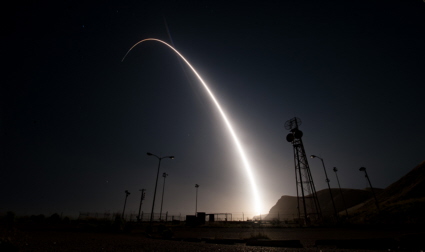
An unarmed Minuteman III intercontinental ballistic missile launches during an operational test April 26 from Vandenberg Air Force Base, Calif. (U.S. Air Force photo/Senior Airman Ian Dudley)
(APR 26) VANDENBERG AIR FORCE BASE, Calif. -- A combined team of Air Force Global Strike Command Airmen launched an unarmed Minuteman III intercontinental ballistic missile equipped with a single test re-entry vehicle April 26, 2017, from Vandenberg Air Force Base. More
(APR 19) The Air Force has awarded Harris Inc., Colorado Springs, Colo. a $7,776,340 modification to an existing contract for software for the PAVE PAWS missile warning radar at Beale AFB, Calif. Harris will maintain the software and resolve obsolesce issues with existing early warning radar systems and improve the detection of incoming missiles. The work is expected to be complete by Feb. 19, 2019.
Brian Webb / Defense Department
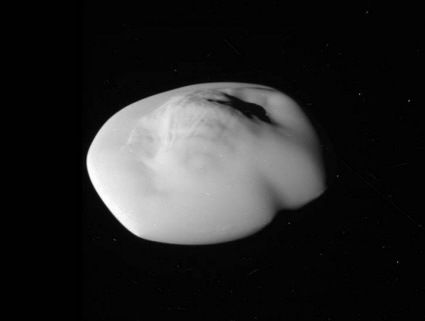
Saturn's moon Atlas resembles a flying saucer in this image from NASA's Cassini spacecraft. The photo is one of several recorded during an April 12 flyby that took Cassini within some 7,000 miles (11,000 kilometers) of Atlas. The images are the closest ever taken of Atlas and will help to characterize its shape and geology. NASA's Jet Propulsion Laboratory in Pasadena, California, manages the Cassini mission for NASA's Science Mission Directorate in Washington, D.C. Credits: NASA/JPL-Caltech/Space Science Institute
(APR 12) AURORA, Colo. -- Raytheon (NYSE: RTN) has completed an upgrade and final testing of the data transport and processing system for the Joint Polar Satellite System Common Ground System which provides weather and environmental data used by NASA, NOAA, the U.S. Department of Defense and the agencies' international partners.
The upgrade accelerates data processing and dissemination, improves system availability and provides cybersecurity protection of the data and the CGS in support of the upcoming JPSS-1 launch as well as future satellite missions.
"The new system will output 11 terabytes of data a day being downlinked from the JPSS constellation," said Matt Gilligan, vice president of Raytheon's Navigation and Environmental Solutions. "JPSS CGS will speed up delivery of weather data to regional forecast centers that build weather models, track environmental aerosols and map polar ice movements."
The system upgrade precedes the final major step – an upgrade of the flight operations elements of the CGS – prior to the JPSS-1 launch scheduled for September 2017.
The Raytheon-built Visible Infrared Imaging Radiometer Suite on JPSS-1, as well as the Raytheon-supported Advanced Weather Interactive Processing System used by NOAA for weather forecasting, rely on the JPSS CGS.
Raytheon
(APR 3) The Missile Defense Agency has awarded the Raytheon Co., Tucson, Arizona, a cost-plus-fixed-fee contract up to $59,608,722 for the Multi-Object Kill Vehicle (KV) technology risk reduction (TRR) effort.
The contract represents part of the Missile Defense Agency's technology risk reduction strategy to improve performance and reduce risk for secure communications systems, high sensitivity multi-band sensor, survivable processor, KV divert and attitude control system, bus sensor and sensor pointing, and engagement management.
The work will be performed in Tucson, Arizona and the estimated contract completion date is April 2, 2020.
Brian Webb / Defense Department
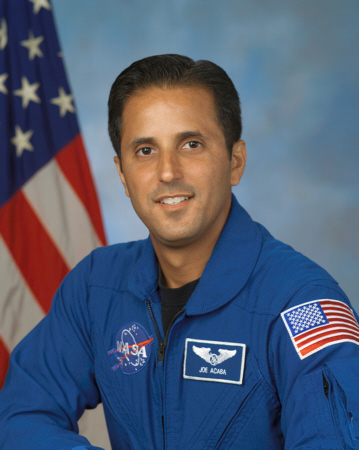
This week NASA announced the selection of astronaut Joe Acaba for a mission to the International Space Station scheduled to begin in September. Born in Inglewood, California, and raised in Anaheim, California, Acaba earned a bachelor's degree in geology at University of California in Santa Barbara, one master’s degree in geology from the University of Arizona, and one in education, curriculum and instruction from Texas Tech University. This will be Acaba’s third trip to the space station and his second long-duration mission. Image credit: NASA
(MAR 28) NASA officially has launched a new resource to help the public search and download out-of-this-world images, videos and audio files by keyword and metadata searches from NASA.gov. The NASA Image and Video Library website consolidates imagery spread across more than 60 collections into one searchable location.
NASA Image and Video Library allows users to search, discover and download a treasure trove of more than 140,000 NASA images, videos and audio files from across the agency’s many missions in aeronautics, astrophysics, Earth science, human spaceflight, and more. Users now can embed content in their own sites and choose from multiple resolutions to download. The website also displays the metadata associated with images.
Users can browse the agency’s most recently uploaded files, as well as discover historic and the most popularly searched images, audio files and videos.
NASA
(MAR 21) No one keeps time quite like NASA. More

Global atmospheric ammonia distribution trends for 2002 to 2016 are revealed in this map complied using data from NASA's Aqua satellite. Hot colors represent increases while cool colors show decreases. Information on atmospheric ammonia distribution could lead to strategies to control pollution from ammonia and ammonia byproducts in agricultural areas. Aqua was launched from Vandenberg AFB, Calif. in 2002. Image credit: Juying Warner/GRL
(MAR 18) The Air Force Space and Missile Center has awarded Hawthorne, Calif.-based SpaceX a $96,500,490 fixed-price contract to launch the third Global Positioning System (GPS) III satellite.
Plans call for a SpaceX Falcon 9 rocket to launch the spacecraft from Cape Canaveral Air Force Station, Florida in February 2019.
GPS III is the next generation of GPS satellites and will feature improved immunity to jamming and greater accuracy for precision navigation and timing. The contract award marks a milestone in the Air Force's effort to make the process of awarding launch service contracts for U.S. national security payloads more competitive.
Brian Webb
(MAR 6) A radio telescope array being built in South Africa to explore the period after stars first formed in the early universe has received $5.8 million in new funding from the Gordon and Betty Moore Foundation. More
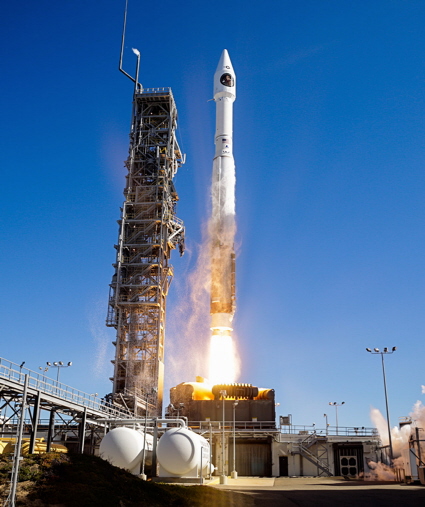
An Atlas V rocket carrying a national security payload lifts off on March 1 from Space Launch Complex-3 East at Vandenberg AFB. Image: Air Force Space and Missile Center
(MAR 1) LOS ANGELES AIR FORCE BASE – EL SEGUNDO, Calif. -- The U.S. Air Force and its mission partners successfully launched a United Launch Alliance Atlas V vehicle carrying a National Reconnaissance Office (NRO) national security payload from Vandenberg Air Force Base, California, today at 9:49 a.m. PST.
“This launch is a testament to the teamwork between the Air Force and its mission partners," said Lt. Gen. Samuel Greaves, Space and Missile Systems Center commander and Air Force program executive officer for Space. “Congratulations to the NROL-79 integrated team of government and industry partners for a successful launch.”
Air Force Space and Missile Center
(FEB 24) VANDENBERG AIR FORCE BASE, Calif. - Team Vandenberg is scheduled to launch a United Launch Alliance Atlas V rocket carrying a National Reconnaissance Office payload from Space Launch Complex-3 on Wednesday, March 1, with a launch window opening at 9:49 a.m. PST.
Col. J. Christopher Moss, 30th Space Wing commander, will be the launch decision authority.
"We are postured for another successful Atlas launch," said Moss. "These missions are critical, and our team is excited to be a part of something that will have a global impact."
The 4th Space Launch Squadron is in charge of mission assurance and safety for this launch operation.
"These launches require constant communication with a widespread team, especially with the unique challenges we faced during this mission," said Lt. Col. Eric Zarybnisky, 4th Space Launch Squadron commander and Air Force Launch Director for this mission. "With the wildfires and recent rains, the Air Force team worked closely with the United Launch Alliance to ensure a successful and safe launch."
Vandenberg AFB
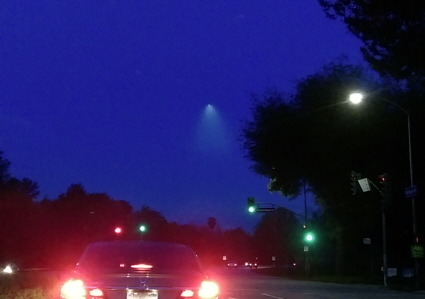
A Trident missile climbs into the dawn sky following launch from a submarine off the California coast on February 14. Here, the missile's exhaust plume is illuminated at high altitude by the Sun while the sky is still dark for observers on the ground. Bill Michaelis took this photo from Van Nuys, Calif. while driving in his car. Image copyright 2017, Bill Michaelis. Used with permission
(FEB 17) Observers over a wide area were treated to an interesting display at dawn on Tuesday thanks to the unannounced launch of two U.S. Navy Trident missiles.
The launches took place from an Ohio class submarine off the California coast. The powered phase and the aftermath of one or both launches were seen in the Bay Area and San Jose, Campbell, Costa Mesa, and Van Nuys, California.
Veteran launch watcher Rick Baldridge reported from northern California that the display "Was a good one. Saw the staging, etc. Perfect sunlight conditions - nice exhaust plume in a dark sky!"
Brian Webb
(FEB 9) BARKSDALE AIR FORCE BASE, La. – A team of Air Force Global Strike Command airmen from the 91st Missile Wing at Minot Air Force Base, North Dakota, launched an unarmed Minuteman III intercontinental ballistic missile equipped with test reentry vehicles Feb. 8 at 11:39 p.m. Pacific [Standard] Time from Vandenberg Air Force Base, California. More
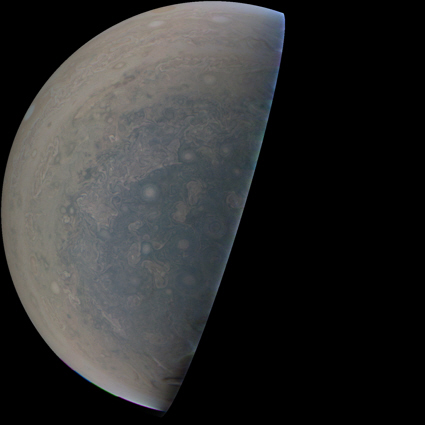
Cyclones swirl and white oval storms are visible in this image of Jupiter's south polar region taken by NASA's Juno spacecraft. Lockheed Martin Space Systems, Denver, built the spacecraft. Image credit: NASA/JPL-Caltech/SwRI/MSSS
(FEB 2) EL SEGUNDO, Calif. – Boeing and the U.S. Air Force recently signed a Global Positioning System (GPS) sustainment agreement that will ensure the navigation capabilities relied upon by millions of military and commercial users remain robust for years to come.
Under the agreement, Boeing will support GPS IIA and IIF satellites currently on orbit for the next five years. Boeing, which has been the prime GPS contractor for more than 40 years, is now part of the Air Force effort that may lead to the next generation of GPS satellites.
Collectively, Boeing GPS satellites have accrued more than 550 years of on-orbit operation. In March 2016, the company delivered its 50th GPS satellite on orbit to the Air Force and has built more than two-thirds of the GPS satellites that have entered service since 1978.
Boeing
(JAN 25) A new study of the first year of observational data from NASA's Soil Moisture Active Passive (SMAP) mission is providing significant surprises that will help in modeling Earth's climate, forecasting our weather and monitoring agricultural crop growth. More
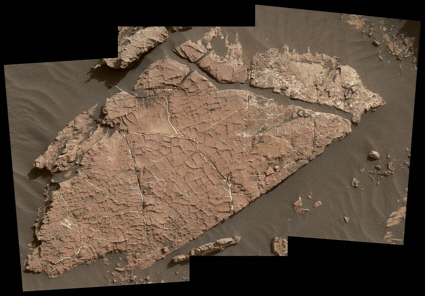
The network of cracks in this Martian rock slab called "Old Soaker" may have formed from the drying of a mud layer more than 3 billion years ago. The view spans about 3 feet (90 centimeters) left-to-right and combines three images taken by the MAHLI camera on the arm of NASA's Curiosity Mars rover. The Jet Propulsion Laboratory in Pasadena, California, manages the Mars Science Laboratory Project for the NASA and built the project's Curiosity rover. Image: NASA/JPL-Caltech/MSSS
(JAN 17) New tracking data confirms that NASA’s OSIRIS-REx spacecraft aced its first Deep Space Maneuver (DSM-1) on Dec. 28, 2016. The engine burn sets up the spacecraft for an Earth gravity assist this fall as it continues its two-year journey to the asteroid Bennu.
The large maneuver was the first using OSIRIS-REx’s main engines and resulted in a 964 miles per hour (431 meters per second) change in the vehicle’s velocity utilizing 780 pounds (354 kilograms) of fuel.
DSM-1 represents the first major, post-launch milestone for OSIRIS-REx. The significant change in trajectory from DSM-1 was necessary to put OSIRIS-REx on course for an encounter with Earth in September of this year.
A smaller trajectory correction maneuver will be executed on Wednesday, Jan. 18 to refine the course for the Earth flyby, during which Earth’s gravity will bend the OSIRIS-REx trajectory and slinging it toward a rendezvous with the asteroid Bennu in the fall of 2018.
Dante Lauretta of the University of Arizona, Tucson, is the principal investigator, and the University of Arizona also leads the science team and the mission’s observation planning and processing. Lockheed Martin Space Systems in Denver built the spacecraft and is providing spacecraft flight operations.
University of Arizona
(JAN 14) A Falcon 9 rocket carrying 10 Iridium Next communications satellites was successfully launched at 9:54:39 PST this morning from Vandenberg AFB, Calif. Iridium Communications, Inc. reports the satellites were successfully delivered into low-Earth orbit about one hour after launch.
I observed the launch with several aerospace enthusiasts from a high bluff west of Newbury Park, approximately 100 statute miles east-southeast of the launch site. The first stage's orange flame and contrail were easily visible to the unaided eye.
Using tripod-mounted 10x50 binoculars, I could clearly see the rocket's shape and shock diamonds in the first stage's flame. As the Falcon 9 gained altitude, the binoculars showed an expanding, tenuous exhaust plume. Following stage 1/2 separation, the shapes of both stages and the widening gap between them were visible through the binoculars.
I attempted to continue tracking the first stage after separation in hopes of seeing re-ignition of the engines for the subsequent soft-landing attempt. Unfortunately, shortly after staging, my binoculars suddenly unlocked, pitched up, and pointed in the wrong area of the sky. I regained control of the binoculars and scanned the sky, but could not find the first stage.
Brian Webb
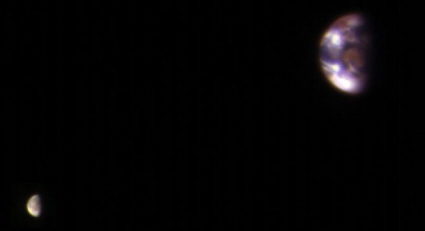
From the most powerful telescope orbiting Mars comes a view of Earth and its moon. The image combines two data calibration exposures taken on November 20 by the High Resolution Imaging Science Experiment (HiRISE) camera on NASA's Mars Reconnaissance Orbiter. The exposures were processed separately to optimize detail on Earth and the moon. The University of Arizona, Tucson operates HiRISE for the Jet Propulsion Laboratory and NASA. Image Credit: NASA/JPL-Caltech/Univ. of Arizona
(JAN 8) Monday’s planned launch of a Falcon 9 rocket from Vandenberg Air Force Base has been delayed. The launch is tentatively scheduled for Saturday, January 14.
Hawthorne, California-based SpaceX, builder of the Falcon 9, plans to launch the rocket at 9:54:34 a.m. PST from Space Launch Complex 4-East at south Vandenberg. If the launch goes as planned, the rocket will rise vertically for several seconds, gradually turn southward, and carry ten Iridium Next communications satellites into orbit.
The best location for the public to view the launch is probably the west side of Lompoc near state highway 246. If the weather cooperates, the bright orange flame from the rocket’s first stage could be visible over a wide area.
It is not known if SpaceX plans to make a powered landing of the rocket’s first stage.
This will be the first launch of a Falcon 9 rocket since the catastrophic explosion of a Falcon 9 on the launch pad during a test in Florida last September.
Brian Webb
Copyright © 2018, Brian Webb. All rights reserved.